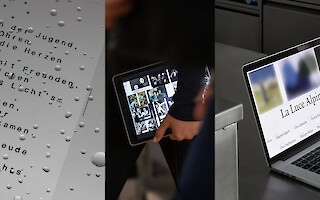[DE]
Von exklusiven Originalen auf Papyrus über die maschinelle Reproduktion mit beweglichen Lettern hin zum gedruckten Massenmedium. Die Entwicklung des Buches folgte stets dem Ziel einer breiteren Zugänglichkeit des Inhalts. Die logische Folge wäre die vollständige Digitalisierung des Mediums.
Diesen Tendenzen widersetzt sich die Kulturpublikation.
Trotz der digitalen Möglichkeiten verharrt sie in ihrer physischen Form als Liebhaberobjekt. Die gängigen E-Book-Formate fokussieren auf Textverarbeitung. Für ein Kunst- und Kulturbuch, in dessen Gestaltung mittels Haptik, Form und Struktur ein individuelles Ganzes angestrebt wird, ist diese Lösung zu eindimensional und emotionslos.
Die Zukunft der digitalen Kulturpublikation sehen wir daher als dynamische Website – global zugänglich, multimedial, vernetzt und dem Kontext entsprechend strukturiert und gestaltet.
Im Web kann nicht geblättert werden. Welches sind also natürliche Bewegungen, wie funktioniert ein neuer Lesefluss ohne haptische Indikatoren? Wie können die fragmentarischen Lesegewohnheiten zum Vorteil der Publikationen genutzt werden? Welche Möglichkeiten entgehen dem gedruckten Buch aufgrund seiner statischen Form? In unserer Arbeit suchen wir exemplarisch nach Ansätzen und Möglichkeiten der Darstellung und Strukturierung einer Kulturpublikation in digitaler Umgebung. Mit dem Ziel, eine Sprache zu finden, die nicht Vergangenes zitiert, sondern die Digitalität zum Motiv macht.
[EN]
From exclusive originals on papyrus to machine reproduction with movable letters and all the way to the printed mass medium. The development of the book has always followed the goal of making its contents more widely accessible. The logical consequence would be the complete digitalisation of the medium.
Cultural publications oppose these tendencies.
Despite the digital possibilities, it remains in its physical form as a collector’s item. The common e-book formats focus on word processing. This solution is too one-dimensional and unemotional for an art and culture book, in whose design an individual whole is aimed for by means of haptics, form and structure.
We therefore see the future of digital cultural publication as a dynamic website - globally accessible, multimedial, networked and structured and designed according to the context.
You cannon flip the pages of the web. So what are natural movements, how does a new flow of reading without haptic indicators work? How can fragmentary reading habits be used to the advantage of the publication? What possibilities are missed by the printed book due to its static form? In our work, we are looking for exemplary approaches and possibilities of presenting and structuring a cultural publication in a digital environment. With the aim of finding a language that does not quote the past, but makes digitality a motif.
Nayla Baumgartner, Fabio Menet, Louis Vaucher
BA-Diplom 2020
Mentorat Jonas Voegeli, Matthias Michel
Webseite
